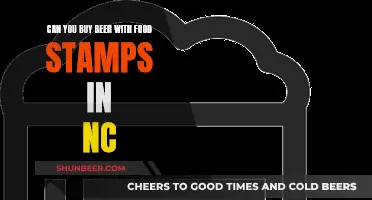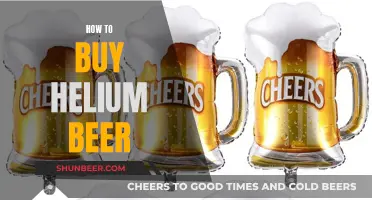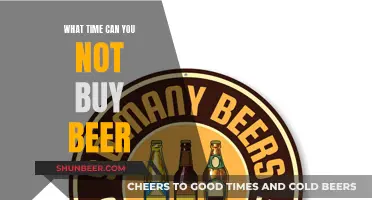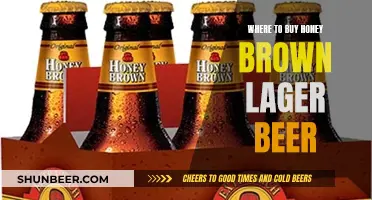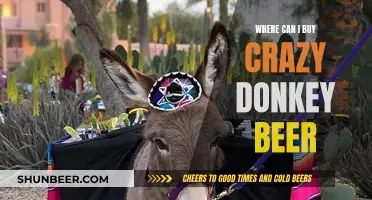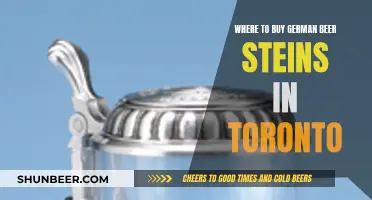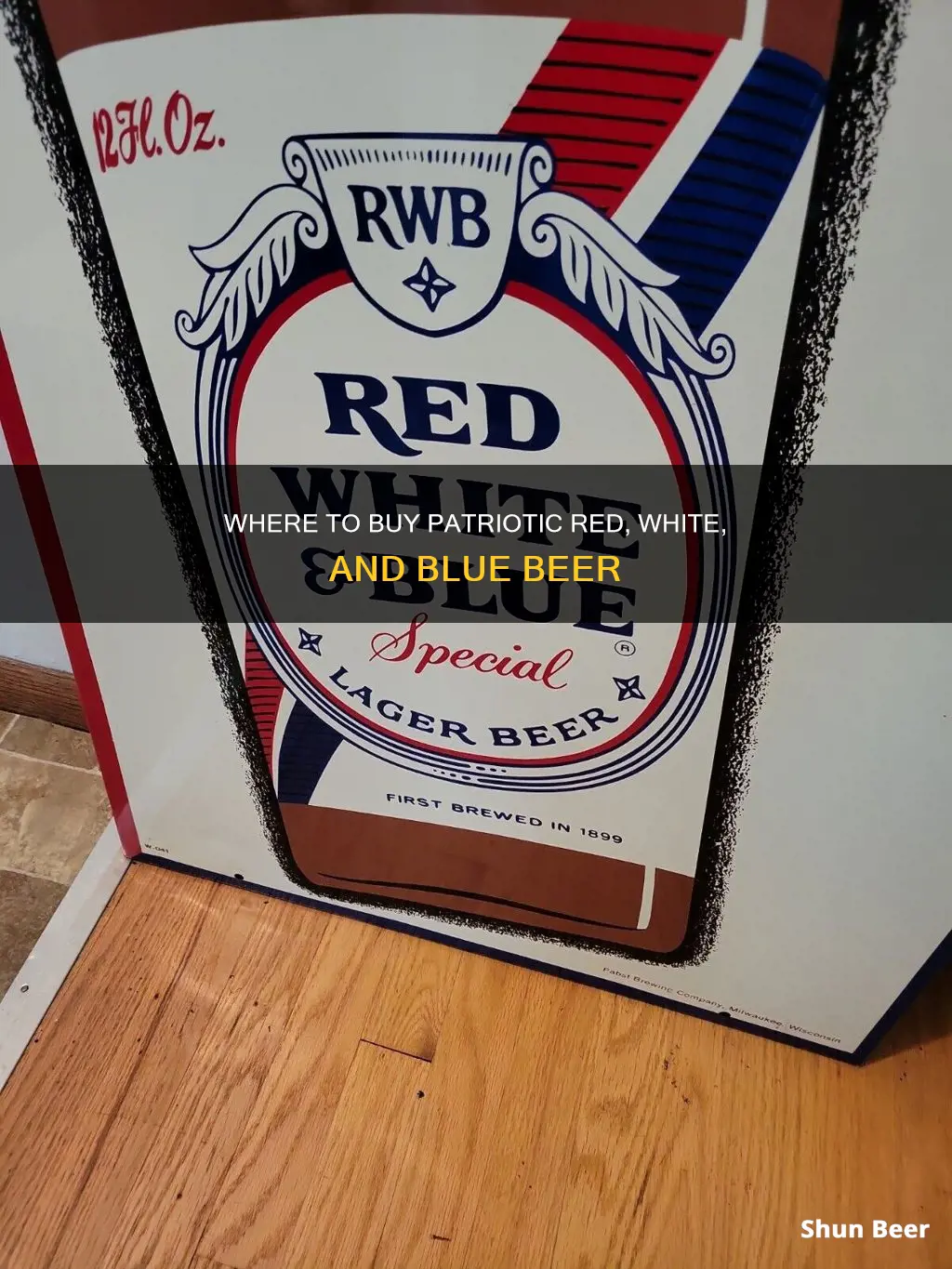
Red, White & Blue Beer was an American beer brand originally produced by the Pabst Brewing Company and later by G. Heileman Brewery. The beer was known for its low price and experienced a resurgence in the early 1980s during the country's economic recession. However, it appears that the beer is no longer in production, as it is not listed on the websites of Pabst or Miller Brewing (which has taken over most of Pabst's brewing operations). While there was talk of reviving the brand in 2010 and a brief revival in 2018, it is unclear if these plans came to fruition.
| Characteristics | Values |
|---|---|
| Brand | Red White & Blue Beer |
| Original Producer | Pabst Brewing Company |
| Later Producer | G. Heileman Brewery of La Crosse, WI |
| ABV | 3.2% |
| IBUs | 10 |
| Patriotic Theme | Yes |
| Price | 89 cents for a 6-pack |
| Availability | Presumed to be out of production |
What You'll Learn

Red White & Blue Beer's price point
Red White & Blue Beer was an American beer brand first introduced by the Pabst Brewing Company in 1899, just in time for the Fourth of July weekend. The name is a nod to the American flag, and the beer was an offshoot of the brand's flagship pilsner. Early advertisements emphasised the beer's mellow taste, drinkability, and low price point, with the slogan "honest beer for an honest price".
In the 1970s, a 6-pack of Red White & Blue Beer cost just 89 cents, making it a very affordable option for consumers. By the 1980s, the brand had experienced a resurgence, coinciding with the country's economic recession. The beer was sold in iconic red, white, and blue cans and cost 50 cents per can, making it a popular choice among budget-conscious drinkers, including college students.
However, the beer received mixed reviews, with some drinkers criticising its taste and quality. Despite its popularity during the recession, Red White & Blue Beer eventually lost momentum and production stopped in the early 2000s. In 2018, Pabst briefly revived the beer at its Milwaukee brewery, but the prices were significantly higher than during its original run, with draft pours costing $4 and 32-ounce to-go crowlers priced at $15.
Currently, Red White & Blue Beer is presumed to be out of production, as it is no longer listed on the Pabst or Miller Brewing websites. However, there have been indications that the company may consider reviving the brand in the future, possibly through a patriotic appeal that contributes to military charities.
Buying Beer in Kansas: Understanding the 10 AM Rule
You may want to see also

The beer's popularity in the '70s and '80s
Red, White & Blue Beer (RWB) was first introduced by the Pabst Brewing Company in 1899, just in time for the Fourth of July weekend. The name is a nod to the American flag, and the beer was initially marketed as a slightly less potent offshoot of the brand's flagship pilsner. Early advertisements emphasised its mellow taste, drinkability, and low price point, with the slogan "honest beer for an honest price".
RWB's patriotic theme and affordability helped it stand out, and sales seemed to increase whenever the US entered into conflict, including World War II and subsequent wars. Even in the 1970s, G.I.s were said to be loyal to the brand, with many drinking nothing else. During the 1970s, a 6-pack of RWB cost just 89 cents, making it a popular choice for those looking for a cheap beer.
By 1980, a recession had hit the US, which was good news for a budget beer like RWB. Pabst upgraded the packaging from a stubby bottle to a more iconic red, white, and blue can. The brand redesign was accompanied by a series of radio commercials that played on the beer's patriotic image. The ads suggested that RWB was a cheaper and more suitable option for promoting America abroad than foreign aid, and that the beer be sent overseas instead of expensive equipment. The commercials were a huge success, with RWB sales climbing by 60% in the months after they aired.
Around this time, RWB also gained popularity with college students at Milwaukee's Marquette University, who used it for a risqué tradition known as the "naked beer slide". The Avalanche Bar & Grill, nicknamed "The 'Lanche", was a staple of campus culture and the site of these late-night escapades. Students would strip down and bellyflop onto the concrete floor, which had been made slippery by the dregs of RWB poured onto it. The 'Lanche' was said to sell more RWB per capita than any other tavern in the world during this era.
Short's Beer: California Availability and Where to Buy
You may want to see also

The beer's resurgence in the early 1980s
Red, White & Blue Beer, an American beer brand, experienced a resurgence in the early 1980s, during a period of economic recession in the country. The brand was originally produced by the Pabst Brewing Company and later by the G. Heileman Brewery of La Crosse, Wisconsin.
The resurgence of Red, White & Blue Beer in the early 1980s can be attributed to a combination of factors, including its affordable price, effective marketing campaigns, and popularity among certain consumer segments. Here is a more detailed look at the beer's resurgence during that time:
Affordable Price:
During the economic recession of the early 1980s, many consumers were looking for affordable options, and Red, White & Blue Beer fit the bill perfectly. The beer had a reputation for being low-priced, comparable to other budget-friendly beers such as Hamm's Beer or Schaefer Beer. This made it particularly appealing to drinkers on a budget, including college students and low-income individuals.
Iconic Drinking Establishments:
One iconic drinking establishment that contributed to the resurgence was The Avalanche Bar & Grill, located on the campus of Marquette University. The 'Lanche', as it was nicknamed, was a staple of campus culture and played a crucial role in the beer's popularity. It was rumoured that the bar sold more Red, White & Blue Beer per capita than any other tavern in America or abroad. The beer was sold at a low price of 50 cents per can, making it the beverage of choice for many patrons.
Marketing Campaigns:
The brand's marketing campaigns during the early 1980s also played a significant role in its resurgence. A series of folksy, radio editorial-style commercials by Harmon R. Whittle poked fun at politicians of the day and positioned the beer as a more cost-effective way to promote America abroad than foreign aid. These commercials were highly effective, with sales of the brand climbing by sixty percent after they began airing.
Popularity Among College Students:
In addition to its affordability, Red, White & Blue Beer gained a following among college students, particularly those attending Marquette University. The students started a risqué tradition known as the "naked beer slide" at The Avalanche Bar & Grill, which involved using the beer to create a slicker surface for sliding. This tradition, though controversial, further contributed to the beer's popularity and sales during the early 1980s.
Overall, the combination of its low price, effective marketing, and popularity among certain consumer segments, particularly college students, led to the resurgence of Red, White & Blue Beer in the early 1980s.
Virginia's Sunday Beer Buying: What's the Deal?
You may want to see also

The Avalanche Bar & Grill's role in popularising the beer
The Avalanche Bar & Grill, or the ‘Lanche as it was nicknamed, was a drinking establishment on the campus of Marquette University. It was a popular spot for students, who would often purchase Red White & Blue Beer (RWB) for 50 cents a can. The beer was used to create a slicker surface for the late-night tradition of 'naked beer sliding', where students would strip down and bellyflop onto the beer-soaked concrete floor. The 'Lanche was known for selling more RWB per capita than any other tavern in America or abroad.
The bar played a significant role in popularising the beer, with its low price and patriotic theme resonating with students and other drinkers on a budget. The beer's resurgence in the early 1980s coincided with the country's economic recession, making it an affordable option for those looking for a cheap drink. The 'Lanche's reputation as a seedy tavern and a staple of campus culture further contributed to the popularity of RWB among the student population.
The students' unofficial motto for the venue was "Get your degree at Marquette, but get your education at the 'Lanche," reflecting the bar's integral role in the social life of the university. The tradition of the naked beer slide, though controversial and dangerous, also attracted attention to both the bar and the beer. Students would commonly smash their bottles of RWB against the wall, creating a hazardous environment that eventually led to the ritual's end in 1991 when a female student was caught by undercover police.
The closure of the Avalanche Bar & Grill in 1997 marked a turning point for the popularity of RWB. With the loss of its most loyal patrons, the beer began to lose momentum, and its production slowed as its audience tapered off. By the early 2000s, RWB production had stopped entirely, and the brand is now presumed to be out of production.
While it is unclear if Red White & Blue Beer will ever be revived, the role of the Avalanche Bar & Grill in popularising the beer among students and budget-conscious drinkers remains a significant chapter in its history.
Buying Beer at Wawa in Pennsylvania: What's the Deal?
You may want to see also

The beer's presumed discontinuation
The Red White & Blue Beer brand was originally produced by the Pabst Brewing Company and later by the G. Heileman Brewery of La Crosse, Wisconsin. The Pabst Brewing Company had threatened to bring it back to Milwaukee in 2018, but this revival was short-lived, lasting only from July 2018 until 2020 when the taproom closed.
The brand is presumed to be out of production, as it is not listed on the Pabst or Miller Brewing websites (Miller has taken over most of Pabst's brewing operations). However, there is some speculation that it may be revived in the future, as the young owners of Pabst have expressed interest in reviving "dead" brands they have the rights to, including Red White & Blue Beer. In a 2010 article in Business Week, owners Evan and Daren Metropoulos discussed their plans to revive the brand through a patriotic appeal that would directly contribute to military charities.
The presumed discontinuation of Red White & Blue Beer may be due to a variety of factors. One reason could be the decline in its target audience, as the beer was known for its low price and popularity among drinkers on a budget, such as college students and low-income individuals. With the rise of craft beer and changing consumer preferences, the demand for cheap beer may have decreased. Additionally, with the surge in popularity of Pabst Blue Ribbon in the early 2000s, RWB production slowed as its audience tapered off, possibly because it was seen as a less favourable, poor man's version of PBR.
Another factor contributing to the presumed discontinuation of RWB could be the challenges of maintaining brand relevance and differentiation. With its patriotic theme, the beer's sales seemed to spike in tandem with U.S. conflicts, such as World War II and subsequent conflicts. However, by the early 2000s, the beer may have struggled to stand out in a market saturated with similar options. Many macro beers employ Americana marketing, evoking images of fishing, camping, and BBQs, making it difficult for RWB to maintain its unique appeal.
Dodger Stadium Beer Buying Experience: Can I Purchase Some?
You may want to see also
Frequently asked questions
Red White & Blue Beer is presumed to be out of production and is no longer listed on the Pabst website. However, it was briefly revived in July 2018 at the Pabst Milwaukee brewery and taproom.
Red White & Blue Beer was a brand of American beer, originally produced by the Pabst Brewing Company and later by G. Heileman Brewery. It was known for its low price and thus its popularity among drinkers on a budget.
Reviews of the beer are mixed. Some describe it as "dirt cheap, somewhat satisfying, and American as it gets", while others deem it "the worst thing I've ever tasted".
The name is a nod to the American flag.


